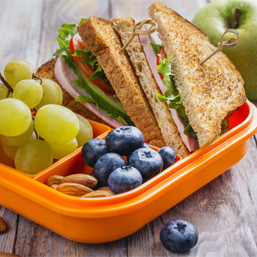
Along with reducing kids’ physical activity, the ongoing pandemic is affecting what, when, and how much kids eat.
With healthy food in shorter supply for many families, children are making up the difference with empty, junk-food calories, says Phuong V. Truong, RDN, clinical dietitian with the Odessa Brown Children’s Clinic. “At this time, the direct need is access to healthy food. Kids no longer have access to meals at school, and we have families who no longer have access to food drops because of COVID.”
The negative health impacts could take years to reverse, particularly for children in lower-income households, those with one caregiver at home or those already struggling to put food on the table before COVID, says Truong. For families with kids learning at home, finding time to shop for fresh foods is a problem, especially if parents also need to work while they supervise remote schooling. “Either parents need to find childcare just to go shopping for food, take young kids to the store, or pay extra for grocery delivery, which can be costly. And food costs are rising, so dollars don’t stretch as far as they used to,” says Truong.
Free and low-cost sources of nutritious foods, like community vegetable gardens, are non-existent during winter, so access to nutritious food probably won’t improve over the next few months. “I’m seeing kids with health conditions like obesity and fatty liver disease worsening, with less physical activity and no change in sight,” says Truong. “It really scares me, because we’re still in survival mode at this point. We haven’t had time to evaluate what’s going on, let alone intervene, so this isn’t even being addressed,” she says.
How to encourage healthy eating at home without turning into the pantry police?
Create meal patterns. You can’t control global food supply, but you can protect your own stash. Keep kids from devouring an entire weeks’ worth of groceries in a sitting by setting up boundaries: stick to regular meal and snack times, with only water offered in between. Schooling at home should not mean children have unrestricted access to food throughout the day, notes Truong. Constantly hitting the cabinet or fridge for snacks racks up unneeded calories and strains the family’s food supply.
Establish non-food comforts, rewards, and ‘fidgets.’ Lots of kids are overeating out of stress, boredom, or to pass the time during long remote learning sessions, says Truong. Break out of these budget-busting ruts with non-food alternatives. Rewards could include a family drive or walk, a movie, or an at-home mani-pedi night; a bath, music, or playtime with a pet can relieve stress; fidget spinners or a sketch pad and pencil can keep hands busy without snacking during Zoom meetings.
Stretch food dollars farther. Food costs may be rising, but fresh produce and bulk foods are still budget-friendly bets for families, says Truong. Shop the perimeter of the store first to fill your cart with low-cost foods like fruits and vegetables, then skim the aisles for healthy packaged items like popcorn, oatmeal, canned fruit packed in water, frozen vegetables, beans, and pasta.
Cook together instead of ordering out. Establish a regular COTR (clean out the refrigerator) night to ensure that leftovers are eaten instead of tossed; stir-fries, curries, and soups are easy ways to use leftover meats and vegetables. Use low-cost convenience foods like salsa and salad dressings as cooking aids: ½ cup of salsa adds flavor to a pot of black bean soup; a dash of your family’s favorite salad dressing turns boiled diced potatoes into a hearty, healthy side dish. Use the last few shreds of chicken on tomorrow’s salad or that last bit of spaghetti sauce as a base for homemade pizza.
Enlist older kids in food prep or baking to keep grocery runs and takeout orders to a minimum. You don’t need a vigorous sourdough base, a bread machine, or even a talent for baking to make simple, low-cost bread for sandwiches or toast. Buy active dry yeast in bulk and stock up on flour to bake up toasty fresh bread that can be served alone or alongside comforting, nourishing homemade meals.
Malia is a health and family journalist.
Calgary’s Child Magazine © 2024 Calgary’s Child